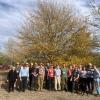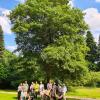Editor's Picks
Plant Focus
Presentation given at the XX International Botanical Conference, Madrid, Spain, July 21–27, 2024.
Authors:
Elena Corredoira, Mª Teresa Martínez
Affiliation:
Misión Biológica de Galicia (MBG-CSIC), Sede de Santiago de Compostela, Avd. Vigo, s/n, 15705, Santiago de Compostela, La Coruña, Spain
Abstract:
The genus Quercus, which includes more than 400 species of oak, is found throughout the northern hemisphere in a wide diversity of habitats. Oak forests play vital social, ecological and economic roles.However, the sustainability of oak populations is currently threatened by habitat loss caused by, among other factors, human-mediated disturbance, adverse environmental conditions, attack by pathogens and pests and in particular by a complex disease commonly known as “oak decline”. The conservation of oak species is therefore of great importance. Biotechnological tools based on in vitro cultivation, such as micropropagation and cryopreservation, are considered good alternatives to other classic conservation strategies (i.e. in situ conservation or field collections). In vitro culture techniques enable conservation of the germplasm of woody species that undergo vegetative propagation or that produce recalcitrant seeds; they also enable the conservation of biotechnology-derived products. The present work revises the main advances in the conservation of oak genetic resources using biotechnological tools based in vitro techniques. Different strategies are reported for short- and medium-term (micropropagation) and also long-term conservation (cryopreservation in liquid nitrogen) of oak. In the first approach, shoot cultures and somatic embryos are maintained by periodic subculture (4-6 weeks), often indefinitely. In addition, the subculture period can be greatly extended (12 months or even longer) by subjecting the cultures to slow growth conditions (i.e. low temperature, illumination or nutrients). Long-term conservation procedures have also been developed for different oak species by cryopreserving somatic embryos. Cryopreservation of somatic embryos was performed following vitrification- and desiccation-based procedures. Comparative studies of these methods clearly showed that the vitrification-based procedure yielded the highest recovery rates.
Source of Funding:
This research was partly funded by Ministerio de Ciencia e Innovación (MICIN, Spain), through the project PID2020-112627RB-C33.
















